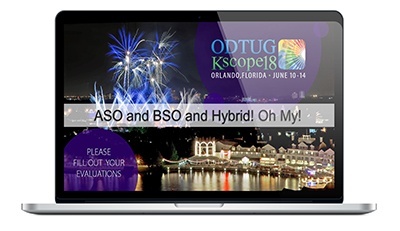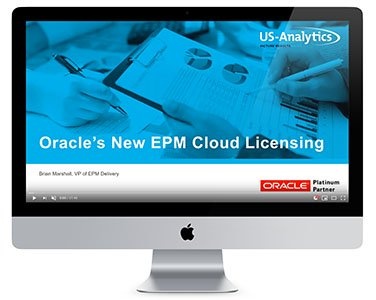The EPM landscape is changing. Gone are the days of terms like “HFM Consultant” and “Essbase Consultant” - we’ve officially entered the era of the “EPM Consultant.” Siloed skillsets are no longer applicable in the EPM world.
Change can be overwhelming, but it doesn’t have to be. We’ve uncovered the top six things that you need to know about the new Oracle EPM Cloud and outlined them here.
1. Shift in licensing
The shift in licensing is the biggest change we’ve seen with the new Oracle EPM Cloud. In the past, Oracle has always had different products for all of your EPM needs. The old structure of licensing for Oracle EPM Cloud is modeled after that of the on-prem structure, giving you an individually sold product for each process (planning and forecasting, financial close and consolidation, account reconciliations, etc.). Under this previous cloud structure, you were also billed individually per user per month in an a la carte pricing structure.
For instance, planning and budgeting (PBCS) previously cost $120 per user per month. If an enterprise wanted to add narrative reporting (EPRCS) or account reconciliation (ARCS), it would cost an additional $120 per user per month, and so on and so forth as the enterprise builds up its arsenal of applications offered by Oracle EPM. It’s clear to see how this could add up quickly.
The implementation of even two to three applications of any kind was not only cost-prohibitive both due to upfront costs and ongoing licensing, but it was also complicated to consolidate the applications purchased on the cloud.
Now, Oracle EPM Cloud offers two different products its customers can choose from: Enterprise Performance Management Standard Cloud and Enterprise Performance Management Enterprise Cloud. We’ll look at each product in detail below.
Enterprise Performance Management Standard Cloud
The Enterprise Performance Management Standard Cloud (Standard Cloud) looks like a fantastic deal from the surface. It costs $250 per user per month and includes…
- Account Reconciliation
- Financial Consolidation and Close
- Narrative Reporting, and Planning
Of the four business processes listed as available with the Standard Cloud, only one can be activated, unless you want to incur an additional $2,500 per month per additional application activated. For larger organizations, this might make sense. But for the mid-market accounts with less than 25 users, this is might not be the most cost-effective option.
The functionality of the business processes available with the Standard Cloud is limited as well. For example, PBCS only includes one custom plan type and doesn’t allow its users to make use of Groovy.
Enterprise Performance Management Enterprise Cloud
The Enterprise Performance Management Enterprise Cloud (or Enterprise Cloud) is considerably more comprehensive than the Standard Cloud. Oracle EPM Enterprise Cloud pricing is $500 per user per month and comes with…
- Account Reconciliation
- Enterprise Data Management
- Financial Consolidation and Close
- Narrative Reporting
- Planning
- Profitability and Cost Management
- Tax Reporting
That’s right (cue the Price is Right theme song), you get all of these services. Even better, Enterprise Cloud comes with unlimited pods. For those unfamiliar with the terminology, a pod is one set of instances for a specific set of technology. For instance, a pod of PBCS will include a developer environment and a production environment.
Let’s consider a fictional scenario to see how using the Enterprise Cloud can save your organization money while improving process. Let’s say that our fictional customer has pretty basic, standard needs with one HFM application, three planning applications, five stand-alone Essbase applications, and 100 users.
Some quick math illustrates how users can save money with the new licensing structure. If our sample client pays $25,000 per month for FCCS, $36,000 per month for three applications of PBCS, and another $12,000 per month for another application of PBCS to house Essbase applications, they’re looking at a total of $63,000 per month.
With the new Enterprise Cloud licensing, clients receive the same functionality as our sample client, plus more, for $50,000 per month for 100 users. It’s pretty significant savings, and you have the opportunity to consider other included solutions and automate those processes.
2. Different ways of setting up an instance of PBCS with Enterprise Cloud
While Standard Cloud offers PBCS in one flavor, Enterprise Cloud offers it in three. We’ll consider the three different offerings of PBCS under Enterprise Cloud and what that means for your business.
Custom Planning
Custom Planning can be considered PBCS but with a serious boost. Instead of there being three Aggregate Storage Options (ASO) and three Block Storage Options (BSO), Enterprise Cloud offers six hybrid BSO plan types and six ASO plan types. And for the cherry on top, Groovy is also included.
A quick note on the hybrid BSO front: If you’re a current PBCS client, you can open a ticket to enable hybrid on your current instance of PBCS. Just be certain that you’re well-aware of the implications of working in hybrid before you jump right in (click the image below to learn more).
Module-Based Planning
Module-Based Planning is very similar to EPBCS. It includes the configurable modules and has three hybrid BSO plan types and four ASO plan types, just like EPBCS today. The major difference between Module-Based Planning and EPBCS is the use of hybrid BSO plan types, which again is available for current Planning clients.
Freeform Planning
Freeform Planning is essentially a true “Essbase in the cloud” for Planning users, giving you what Oracle Analytics Cloud (OAC), as an analytics product, couldn’t. It also comes with all the functionality that we’ve had before with Planning. The biggest difference between Freeform Planning and Custom Planning is that Freeform Planning doesn’t have required dimensions any longer. If you use standalone Essbase, Freeform Planning could be pivotal to your new cloud migration.
Currently, with Freeform Planning, you only get one database per application. A future release, scheduled for later in 2019, will allow users to have more than one database per application, but the exact number has not been released yet.
3. Financial Close and Consolidation (FCCS) Changes
With Standard Cloud, the version of FCCS you receive is close to the version of FCCS that initially came out — it still supports two custom dimensions. It now has more out-of-the-box functionality. The FCCS that comes with the Enterprise Cloud is more akin to a new hybrid version that supports custom calculations and complex ownership.
4. Account Reconciliation (ARCS) Changes
The biggest change that came to the account reconciliation front is in how Oracle licenses transaction matching. It basically boils down to this: For the Enterprise Cloud, transaction matching is included via ARCS, and for the Standard Cloud, it’s not. This make enterprise cloud an even better option, with many other account reconciliation solutions selling Transaction Matching as a separate product.
5. Enterprise Data Management (EDMCS) changes
Enterprise Cloud includes 5,000 EDMCS records, while the Standard Cloud lacks EDMCS. More records are available with the Enterprise Cloud for $1,500 per 1,000 nodes per month. The functionality that EDMCS provides makes it an attractive feature of the Enterprise Cloud.
6. Other cloud services changes (EPRCS, PCMCS, TRCS)
For narrative reporting through EPRCS, the difference between the Standard Cloud and the Enterprise Cloud is that there is no disclosure management with the Standard, and with the Enterprise disclosure management is included.
Like so many other features, the only way to get services like profitability and cost management (PCMCS) and tax reporting (TRCS) is to purchase the Enterprise Cloud. And if you’re using PCMCS and TRCS, there’s a strong chance that you’re already utilizing many other tools, making the Enterprise Cloud an attractive option for your organization.
Conclusion
The introduction of cloud computing has changed and continues to change the face of EPM and Analytics platforms. The changes that arrived in the form of the new Oracle EPM Cloud, especially those included with its Enterprise Cloud, continue to revolutionize the EPM landscape. Users of the new Oracle EPM Enterprise Cloud have access to a wide range of services and functionalities that dwarf what was previously available on the cloud, and even users of the Standard Cloud can expect to see changes in the application or applications they choose to implement.
If you’re interested in learning more about adapting one of these cloud options to your processes, schedule an appointment with one of our EPM experts.








